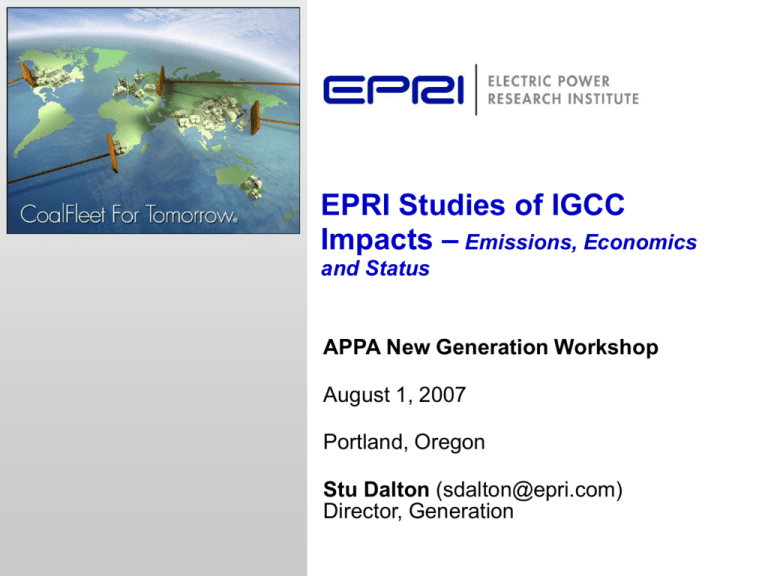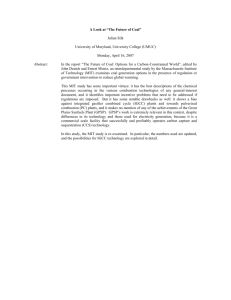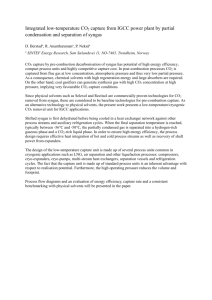
EPRI Studies of IGCC
Impacts – Emissions, Economics
and Status
APPA New Generation Workshop
August 1, 2007
Portland, Oregon
Stu Dalton (sdalton@epri.com)
Director, Generation
U.S. Capacity Additions – All Types
Evaluation of Announcements, 1999 to 2015, as of Fourth Qtr. 2006
Capacity, MW
60,000
US Still
depends on
coal for >50%
of KWh
50,000
40,000
Other
Wind
Nuclear
Coal
Combustion Turbine
Combined Cycle
Retirements
30,000
20,000
10,000
0
-10,000
1999
2001
2003
2005
2007
2009
2011
2013
2015
“Other” includes biomass, solar, hydro, internal combustion, geothermal, pet coke or any other type with announcements available to investigator.
Capacity additions for each year prior to summer peak load season.
Source: Forthcoming “Power Plant Update” prepared for EPRI Program 67 by EVA.
© 2007 Electric Power Research Institute, Inc. All rights reserved.
2
New Technology Deployment Curve for Coal
Research
Development Demonstration
Deployment
Mature Technology
Advanced USCPC Plants
Anticipated Cost of Full-Scale Application
1400°F
CO2
Capture
1150°F+
USCPC Plants
1150°F+
1100°F
IGCC Plants
Oxyfuel
<1100°F
SCPC Plants
CO2 Storage
Time and level of maturity
Not All Technologies at the Same Level of Maturity.
© 2007 Electric Power Research Institute, Inc. All rights reserved.
3
1050°F
Coal Technology Options – w/o CO2 Capture
(approximate data)
NSPS = New Source Performance Standards
PC = Pulvervized Coal
SCPC = Supercritical PC
USPC = Ultra-Supercritical
IGCC = Integrated Gasification
NGCC = Natural Gas
Efficiency
(HHV Basis)
PRB
Bit.
Regulated
SO2
lb/MW-hr
NOX
lb/MW-hr
Particulate
lb/MW-hr
Mercury
NonRegulated
% Reduction
CO2
lb/MW-hr
Water Usage
gal/MW-hr
NSPS
2006
PC Fleet
Average
SCPC
USPC
IGCC
NGCC
(1050°F Steam)
w/ SCR
(1100°F Steam)
w/ SCR
(CoP E-Gas)
w/ SCR
(GE 7FB)
w/ SCR
--
33%
37%
38%
38%
39%
38%
39%
50%
1.4
13
0.3
1.1
0.3
1.1
<0.1
nil
1.0
6
<0.3
<0.5
<0.3
<0.5
<0.2
<0.1
0.2
1
<0.2
<0.2
<0.1
nil
--
~36%
80%
80%
90%
--
--
2,250
1,950
1,900
1,900
1,850
1,850
1,800
800
--
1,200
1,100
1,000
750
600
Relative Emissions Profiles for PC and IGCC are Very Low.
© 2007 Electric Power Research Institute, Inc. All rights reserved.
4
Plant Construction Costs Escalating
Construction Cost Indices
(Source: Chemical Engineering Magazine, March 2007)
1,400
Chemical Engineering Plant Cost Index
540
1,350
Marshall & Swift Equipment Cost Index
520
1,300
500
1,250
480
1,200
460
1,150
440
1,100
420
1,050
400
1,000
380
Jun-98
Jun-99
Jun-00
© 2007 Electric Power Research Institute, Inc. All rights reserved.
Jun-01
Jun-02
Jun-03
5
Jun-04
Jun-05
Jun-06
950
Jun-07
Marshall & Swift Equipment Cost Index
Chemical Engineering Plant Cost Index
560
Capital Cost Estimates in Press
Announcements and Submissions to PUCs
2006-7 — All Costs Are Way Up!
Owner
Plant Name/
Location
Net MW
Technology/C
oal
Reported
Capital
$ Million
Reported
Capital $/kW
AEP
SWEPCO
Hempstead,
AR
600
USC PC/PRB
1680
2800
AEP
PSO/OGE
Sooner, OK
950
USC PC/PRB
1800
1895
AEP
Mountaineer,
WV
629
GE RQ IGCC/
Bituminous
2230
3545
Duke Energy
Edwardsport,
IN
630
GE RQ IGCC/
Bituminous
1985
3150
Duke Energy
Cliffside, NC
800
USC PC/Bit
2400
3000
NRG
Huntley, NY
620
IGCC/Bit, Pet
Coke, PRB
1466
2365
Otter Tail/GRE
Big Stone, SD
620
USC PC/PRB
1500
2414
Southern Co
Kemper
County, MS
600
KBR IGCC
Lignite
1800
3000
© 2007 Electric Power Research Institute, Inc. All rights reserved.
6
EPRI PC and IGCC Net Power Output With
and WithoutEPRI
COPC
#6 Coal)
and IGCC Net(Illinois
Power Output
2 Capture
With and Without CO2 Capture (Illinois #6 Coal)
800
No Capture
Net Power Output, MWe
.
700
Retrofit Capture
New Capture
600
500
400
300
200
100
0
Supercritical
PC
© 2007 Electric Power Research Institute, Inc. All rights reserved.
GE Radiant
Quench
GE Total
Quench
7
Shell Gas
Quench
E-Gas FSQ
EPRI PC and IGCC Capital Cost Estimates
With and Without CO2 Capture (Illinois #6 Coal)
600 MW
(net)
PC+10%
and IGCC
Capital Cost
Estimates
(All IGCCEPRI
and CCS
cases
have
Contingency
for FOAK)
With and Without CO2 Capture (Illinois #6 Coal)
5,000
Retrofit Capture
.
Total Capital Requirement, $/kW (2006$)
No Capture
4,500
New Capture
4,000
3,500
3,000
2,500
2,000
1,500
Supercritical
PC
© 2007 Electric Power Research Institute, Inc. All rights reserved.
GE Radiant
Quench
GE Total
Quench
8
Shell Gas
Quench
E-Gas FSQ
EPRI PC and IGCC Cost of Electricity
With and Without CO2 Capture (Illinois #6 Coal)
EPRI
600
MW have
(net) +10%
PC and
IGCC
Cost of Electricity
(All IGCC and
CCS
cases
TPC
Contingency
for FOAK)
With and Without CO2 Capture (Illinois #6 Coal)
30-Yr levelized COE, $/MWh (Constant 2006$)
.
130
No Capture
120
Retrofit Capture
COE Includes $10/tonne for CO2 Transportation and Sequestration
New Capture
110
100
90
80
70
60
50
40
Supercritical
PC
© 2007 Electric Power Research Institute, Inc. All rights reserved.
GE Radiant
Quench
GE Total
Quench
9
Shell Gas
Quench
E-Gas FSQ
Basis for EPRI CoalFleet Program 2006 PC & IGCC
Estimates Report 1013355 - Nth and FOAK
(First of a Kind)
• Total Plant Costs (TPC) include total field costs, engineering, and contingency.
Historically, usually estimated for Nth-of-a-kind plants.
• FOAK costs have not typically been included in previously reported estimates.
However, in view of the current SOA and rapidly escalating costs, an
additional 10% contingency has been added to the IGCC and CO2 capture
designs.
• TCR is also reported because it is believed to be closer to what is reported to
PUCs in project submissions
• For PC plants, EPRI has used a TCR/TPC multiplier of 1.16, and estimates are
shown as range -5% to +10%
• For IGCC plants, EPRI has used a TCR/TPC multiplier of 1.19, and estimates
are shown as range -5% to +20%
• Most previous studies reported cost of capture at the battery limit. In this report,
we have added $10/mt for transportation, monitoring, and storage. So reported
costs include CCS.
• We recognize that the use of these additional contingencies, multipliers, and
ranges for IGCC and CO2 capture is debatable. It is anticipated that they
should be reduced as the technologies mature.
© 2007 Electric Power Research Institute, Inc. All rights reserved.
10
Challenge = Cost
… Recent EPRI Economic Evaluations of SOA Coal
Technologies with CO2 Capture and Sequestration (CCS)
• At the current state-of-the art (SOA) there is no “silver bullet”
technology for CCS. Technology selection depends on the
location, coal, and application.
• IGCC/Shift is least cost for bituminous coals
• IGCC/Shift and PC plants with amine scrubbing have similar
COE for high-moisture subbituminous coals
• PC with amine scrubbing is least cost for lignites
• CFBC can handle high-ash coals and other low-value fuels
• Oxy-fuel (O2/CO2 Combustion) and chemical looping are
technologies at developmental stage
© 2007 Electric Power Research Institute, Inc. All rights reserved.
11
Coal Characteristics Drive Technology
Selection
IGCC w/ CCS
Bituminous Coal
Sub-Bituminous Coal
PC w/ CCS
Usually Favored
Water use limits
Lower elevation
Lower moisture
Lower ash
Higher elevation
Higher moisture
Higher ash
Higher ambient temp.
Lignite Coal
Usually Favored
Nth Plant Economics
© 2007 Electric Power Research Institute, Inc. All rights reserved.
12
Integrated Gasification Combined Cycle
(IGCC) With CO2 Removal
Coal
Air
ASU
Gasifier
Sulfur
CO2
Gas
Clean
Up
Shift
O2
CC
Power
Block
Power
H2
Slag
Steam
IGCC with CO2 Capture
(e.g., FutureGen, Carson
Hydrogen Power Project)
Shift
Reactor
CO2 Compressor
Sulfur
Recovery
Needs Space, Energy and Integration.
© 2007 Electric Power Research Institute, Inc. All rights reserved.
CO2
Sulfur Product
13
CO2
Recovery
(e.g., Selexol
2nd stage)
Coal Gasification Plants w/CO2 Capture (USA
Today)
• IGCC and CO2 removal offered commercially:
– Have not operated in an integrated manner
• Three U.S. non-power facilities and many
plants in China recover CO2
– Coffeyville
– Eastman
– Great Plains
The Great Plains Synfuels Plant
http://www.dakotagas.com/Companyinfo/index.html
• Great Plains recovered CO2 used for EOR:
– 2.7 million tons CO2 per year
– ~340 MWe if it were an IGCC
No Coal IGCC Currently Recovers CO2
© 2007 Electric Power Research Institute, Inc. All rights reserved.
14
Weyburn Pipeline
http://www.ptrc.ca/access/DesktopDefault.aspx
Pulverized Coal With CO2 Capture “Today”
Fresh Water
Coal
Air
PC
Boiler
Steam
Turbine
Reduce
NOx
Reduce
Ash
SCR
ESP
Fly Ash
Reduce
Sulfur
CO2 to Use or
Sequestration
CO2
Removal
e.g., MEA
FGD
Flue Gas
to Stack
CO2 to Cleanup
and Compression
Gypsum/Waste
Cleaned Flue Gas
to Atmosphere
CO2
Stripper
• Pre-condition Flue Gas (Clean)
less than 1 PPM SOx allowed?
• Absorb CO2
• Strip CO2
• Requires significant energy
Absorber
Tower
Flue Gas
from Plant
CO2
Stripper
Reboiler
Needs Space, Integration and Energy.
© 2007 Electric Power Research Institute, Inc. All rights reserved.
15
US Coal Units Operating Units w/ CO2 Capture
(Today)
• Three U.S. small plants in operation today:
– Monoethanolamine (MEA) based
• CO2 sold as a product or used:
– Freezing chickens
– Soda pop, baking soda
– ~140 $/ton CO2 (claim by operators)
• 300 metric tons recovered per day:
– ~15 MWe power plant equivalent
• Many pilots planned and in development:
– 5 MW Chilled Ammonia Pilot
– Many other processes under development
AES Cumberland ~ 10 MW
EPRI
CO2
(Report 1012796)
Assessment of PostCombustion Carbon
Capture Technology
Only Demonstrated on a Small Scale to Date.
© 2007 Electric Power Research Institute, Inc. All rights reserved.
16
Challenge- Regulatory Uncertainty on CO2
Emissions
•
•
•
•
Kyoto Signatory Countries post 2012. New G-8 Proposals
New Motion in Australia, EU
US proposed Federal legislation Intense in Washington – MANY bills
US Regional Initiatives
– Western Regional Climate Action (WA,OR,CA,AZ, and NM).
Western Governors Association (WGA)
– RGGI – East Coast Regional GHG Initiative (10 NE States)
– Powering the Plains (ND,SD,IA,MN,WI, Manitoba)
• California, Washington - others…
– New long term base load power or renewal (>5years)
commitments shall have CO2 emissions no greater than NGCC
(established as <1100 lbs/MWh ~ 500 kg/MWh).
• Liability of CO2 injection into geological formations? New questions
with BP “Carson Hydrogen Power Project” project in California
© 2007 Electric Power Research Institute, Inc. All rights reserved.
17
Preparing for Carbon Constraints
Variation of Plants
Variation Geology
CO2 Capture
• Plant Efficiency
• Capture Technology
• Capture Pilots
• Capture Demonstrations
Confirmed Long Term
Sequestration
Address Societal
Concerns
• Test Multiple Geologies
• Liability
• Well Integrity
• Health
• Monitoring
• Public Acceptance
Multiple Challenges Requiring Concurrent Resolution.
© 2007 Electric Power Research Institute, Inc. All rights reserved.
18
CoalFleet for Tomorrow is an International
Collaboration on Clean Coal including CO2 Capture
• Participants from 5 continents , Asia, Australia, Europe,
Africa, North America (2/3 of all coal fired in NA)
• Best design guides developed by industry for industry
• Power Producers, Suppliers, Rail, Coal, engineering
firms, Governmental entities
• Many of the leading “early deployment” firms working with
us to assure successful designs that meet the
performance and operational goals
• New plants starting to look at designs for CO2 capture and
integration
© 2007 Electric Power Research Institute, Inc. All rights reserved.
19
CoalFleet Participants Span 5 Continents
>60% of U.S. Coal-Based Generation, Large European Generators,
Major OEMs (50 & 60 Hz) and EPCs, CEC, U.S. DOE
Alliant Energy Corp.
Alstom Power
Ameren Services Company
American Electric Power
Arkansas Electric Coop.
Austin Energy
Babcock & Wilcox Company
Bechtel Corp.
BP Alternative Energy International
California Energy Commission
ConocoPhillips Technology
Consumers Energy
CPS Energy
CSX Transportation
Dairyland Power Coop.
© 2007 Electric Power Research Institute, Inc. All rights reserved.
20
Doosan Heavy Industries (Korea)
Duke Energy Corp.
Dynegy
EdF (France)
Edison International
Edison Mission Energy
Endesa (Spain)
ENEL (Italy)
Entergy
E.ON UK
E.ON US
ESKOM (South Africa)
Exelon Corp.
FPL
GE Energy (USA)
Golden Valley Electrical Assoc.
CoalFleet Participants Span 5 Continents
(cont’d)
Great River Energy
Hoosier Energy
Integrys Energy Group (WPS)
Jacksonville Electric Authority
Kansas City Power & Light
Kellogg Brown & Root (KBR)
Lincoln Electric System
Midwest Generation
Minnesota Power
Mitsubishi Heavy Industries (MHI)
Nebraska Public Power District
New York Power Authority
Oglethorpe Power
PacifiCorp
PNM Resources
Portland General Electric
© 2007 Electric Power Research Institute, Inc. All rights reserved.
21
Pratt & Whitney Rocketdyne
Richmond Power & Light
Rio Tinto
Salt River Project
Siemens
Southern California Edison
Southern Company
Stanwell Corporation
TransCanada Pipelines Limited
Tri-State G&T
TVA
TXU
U.S. DOE (NETL)
We Energies
Wolverine Power
Xcel Energy
What’s Next – What’s Needed for Coal
• Acceleration of the Industry efforts worldwide in
addition to governmental efforts – new pilots,
demonstrations, initiatives
• Cost reductions and efficiency improvements for the
underlying technology
• Three “strata” of certainty/understanding
– Political/siting, economic, technical
© 2007 Electric Power Research Institute, Inc. All rights reserved.
22
Backup sides
© 2007 Electric Power Research Institute, Inc. All rights reserved.
23
IGCC with CO2 Removal
Steam
Coal
Prep
Gasification
C + H2O =
CO + H2
O2
Sulfur
Shift
CO+ H2O =
CO2 + H2
Gas Cooling
CO2 to use or sequestration
Sulfur and
CO2
Removal
Hydrogen
N2
Air
Separation
Unit
Gas
Turbine
Air
BFW
Air
Steam
HRSG
Steam
Turbine
© 2007 Electric Power Research Institute, Inc. All rights reserved.
24
BFW
IGCC CO2 Retrofit Considerations
• The ideal IGCC that you would build if you knew it would
later be retrofitted with CO2 capture would be quite
different from the ideal IGCC you would build if you knew
it would never capture CO2
– Direct water quenching over syngas coolers
– Coal-water slurry over dry feeding
– Higher gasifier operating pressure
– Physical solvents for acid gas removal
– Capability to handle additional pressure drop in syngas
production train
© 2007 Electric Power Research Institute, Inc. All rights reserved.
25
PC CO2 Capture Retrofit Considerations
• If you are designing a plant today with the idea that some time
during its life it will be retrofitted with capture, there are some
things you should do differently:
– Add space
– Place the plant near a suitable geologic storage site
– Make the plant as efficient as practical – higher efficiency
means less CO2 you will have to capture and compress
– Design emissions controls to either achieve ultra-low SOx
and NOx emissions today, or design the equipment to be
upgraded to ultra-low emissions
– Design steam turbine to accommodate very large extraction
lowadding
pressure
steam
solvent
regenerationmakes a
“Ifofjust
space
forforthe
CO2 equipment
coal power plant capture ready, then my driveway is
Ferrari-ready” – David Hawkins, NRDC
© 2007 Electric Power Research Institute, Inc. All rights reserved.
26
USC Worldwide Experience Curve
US Eddystone 1960 1135F
1112F
© 2007 Electric Power Research Institute, Inc. All rights reserved.
27
IGCC RD&D Augmentation Plan—Expected Benefits Case:
Slurry-fed gasifier, Pittsburgh #8 coal,
90% availability, 90% CO2 capture, 2Q 2005 dollars
Total Plant Cost ($/kW)
2200
2000
Mid-Term:
• ITM oxygen
• G-class to H-class CTs
• Supercritical HRSG
• Dry ultra-low-NOX
combustors
Plant Net Efficiency (HHV Basis)
40
1800
1600
1400
Near-Term:
• Add SCR
• Eliminate spare
gasifier
• F-class to G-class CTs
• Improved Hg detection
1200
2005
2010
© 2007 Electric Power Research Institute, Inc. All rights reserved.
38
Long-Term:
• Membrane separation
• Warm gas cleanup
• CO2-coal slurry
36
Longest-Term: 34
• Fuel cell
hybrids
32
2015
2020
28
2025
30
2030
USC PC RD&D Augmentation Plan—Expected Benefits Case:
Pittsburgh #8 coal, 90% availability, 90% CO2 capture,
as reported data from various studies (not standardized)
Total Plant Cost ($/kW)
2400
Near Mid-Term:
• Upgrade steam
conditions to
2200
4200/1110/1150
Near-Term:
• Upgrade solvent from MEA
to MHI KS-1 (or equivalent)
2000
• Upgrade steam conditions
from 3500/1050/1050 to
3615/1100/1100
1800
Plant Net Efficiency (HHV Basis)
40
Mid-Term:
• Upgrade steam
conditions to
5000/1300/1300,
and then to
5000/1400/1400/1400
36
34
Long-Term:
• Upgrade solvent
to advanced
sorbents
1600
1400
2005
© 2007 Electric Power Research Institute, Inc. All rights reserved.
2010
38
2015
29
2020
32
30
2025
EPRI’s CoalFleet for
Tomorrow Program
• Build an industry-led program to
accelerate the deployment of
advanced coal-based power plants;
members now span five continents
• Employ “learning by doing” approach;
generalize actual deployment projects Further information available
at www.epri.com/coalfleet
(50 & 60 Hz) to create design guides
• Augment ongoing RD&D to speed market
introduction of improved designs and materials
• Deliver benefits of standardization to IGCC (integration gasification
combined cycle), USC PC (ultra-supercritical pulverized-coal), and SC
CFBC (supercritical circulating fluidized-bed combustion)
–
–
–
–
–
Lower costs, especially with CO2 capture
High reliability
Near-zero SOX, NOX, and PM emissions
Shorter project schedule
Easier financing and insuring
© 2007 Electric Power Research Institute, Inc. All rights reserved.
30






